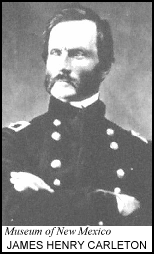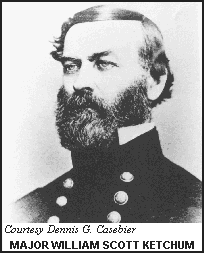Outlaws on the Mojave
Carleton Denounces General Populace
Major Carleton was sent to San Bernardino in July to assess the extent of the secessionist activity. The subsequent report he submitted on the situation in San Bernardino may have reflected his personal sentiments toward the Latter-day Saints.The Major was decidedly anti-Mormon, as were most military men following the Mormon War, but Carleton had a particular reason for disliking them. His enmity was the result of an assignment in 1859 in which he was sent to the scene of the Mountain Meadows Massacre in Utah with orders to bury the remains of the victims and investigate the circumstances surrounding the heinous crime.
His resultant report to the military was published two years later in the Los Angeles Star as a four-part series, beginning with the June 8, 1861, issue. He described the scene in May of 1859 as still horrible to look upon. The bones of little children were scattered about, women's hair still hung in clumps from the bushes, and bleached skulls and bones stretched for an area of two square miles.
The report was very specific; it named those responsible, and detailed the terrible plan conceived and carried out under the direction of what he called "Latter Day Devils." Those Californians reading the report might have agreed with Carleton when he heatedly remarked, "...how inadequate would be the punishment of a few, even by death, for this crime which nearly the whole Mormon population, from Brigham Young down, were more or less instrumental in perpetrating."
With Carleton still carrying the painful memories of the carnage at Mountain Meadows, and what with the rampant criminal and seditious activity occurring in San Bernardino during his investigation, it is hardly surprising that when he submitted his report to General D. C. Buell, he was even more scathing than editor Edwin Sherman in his denunciation of the general populace. Carleton sincerely believed there were few in the town who had principles enough to feel anything like patriotism.
He felt that measures needed to be taken by the military, and stated that the presence of "two or more companies of U. S. troops would encourage and sustain their loyalty to the Union all those who yet have reverence for it, would bring back the wavering, and would exercise a wholesome restraint over the treasonable and vicious." Carleton estimated that 1,000 of the 1500 people then in town were Mormons, and, in his opinion, most of the remaining 500 were also of doubtful character.
On August 25th, Major W. Scott Ketchum arrived in San Bernardino with Companies "D" and "G" of the 4th U. S. Infantry, and two more companies were on the way. The troops remained until March of 1862, at an encampment known as Camp Carleton, which was located near the Timber Settlement. As time progressed, it can be seen through the dispatches of the officers that they came to distinguish between the Mormons, trusting some, especially Judge Boren, but they never did have complete confidence in the loyalty of the general community.
< Previous - Next >
-=-

